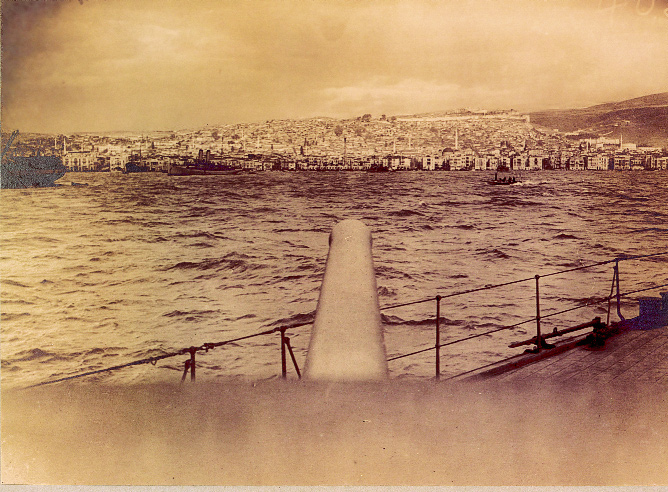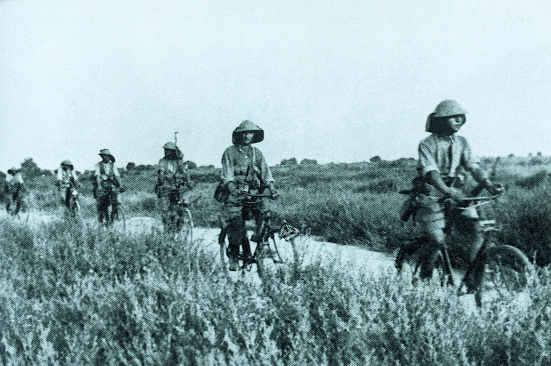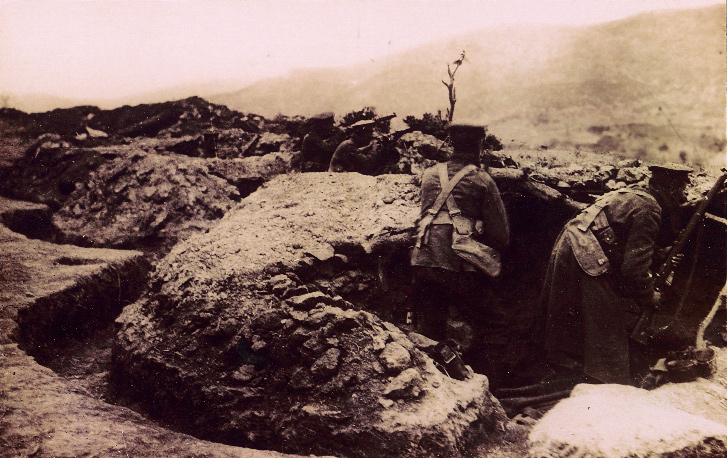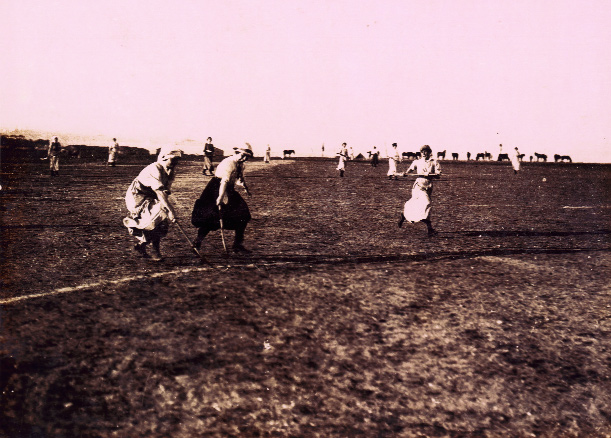
Although the Western Front continues to dominate the popular memory of the First World War in Britain and Ireland, the conflict had its beginnings in eastern Europe, and it was here that it would have its profoundest effects. This often overlooked fact was brought home to the world in the 1990s, when the state of Yugoslavia, one of the Versailles Treaty’s many novel inventions, tore itself apart. The conflict in the east interested Britain little; indeed, in the summer of 1914 the liberal Manchester Guardian, correctly surmising that the Serbian government wasn’t entirely innocent of the Sarajevo crisis, suggested that Serbia ought to be towed out to sea and sunk. Nevertheless Britain would reluctantly send an army to the Balkans, where it stayed, almost in spite of government wishes, for three years.
What is remarkable about this army from an Irish perspective is how often its experience emerges in Irish family histories, for the first British unit to arrive in the Balkans was an Irish one, Lt. Gen. Bryan Mahon’s 10th Division. What’s more, many of those Irishmen who served in the Balkans lived to tell the tale, albeit more often than not with malaria as an unwelcome souvenir of their time there. While remembering the war in post-independence Ireland became politically contentious and ceased as the participants died off, the war in the Balkans was largely forgotten in Britain itself as an unwanted and unsuccessful sideshow.

When Irish troops arrived for peace-keeping missions in Kosovo in 1999, very few Irish families realised that their own relatives had tried to reach that area more than 80 years before as part of the British army. The term ‘Flanders’ became, in independent Ireland, a generic and sometimes dismissive title for all theatres of the European war, but thousands of Irishmen, mainly those who had volunteered in the first rush of war enthusiasm in August and September 1914, served with the British Salonika Force (BSF), whilst many of the country’s nursing volunteers served in the huge medical infrastructure created by Britain in the eastern Mediterranean from 1915 to 1918.
The 10th (Irish) Division and the Chantilly conference
The 10th Division was recruited from ‘K1’, Lord Kitchener’s first 100,000 volunteers. The debut of K1 in battle, the landings at Suvla Bay under the incompetent General Stopford, was far from auspicious. Whilst many of the individual units distinguished themselves in the fighting that followed, the operation as a whole was mismanaged to the point of farce. The commanders of the New Army troops at Suvla did nothing until the Turks had sufficiently reinforced the area to prevent them from being able to do anything. The badly scattered 10th Division suffered heavily in assaulting impregnable hill positions that had been undefended when they first landed. It was a bitter introduction to warfare.
As a result of the Allied failure to force the straits on this, their third effort, Bulgaria decided to enter the war on the side of the altogether more successful Central Powers. This would make the Gallipoli position untenable in the long term, and it also badly exposed Serbia, which had for a year held off the Austro-Hungarian army against all the odds and was proving a useful thorn in the side of the Central Powers. It was decided to send troops from Gallipoli to the Greek port of Salonika to reinforce the Serbs. Like so much Allied activity in 1915, it was half-hearted and only half-thought-out. The 10th was sent to the Serbs more in solidarity than expectation. To make matters worse, the Greek government decided against joining the Allies as the Irishmen disembarked at Salonika, still dressed for the tropics in what would soon be sub-zero conditions.
With the threat of internment by the neutral Greek government hanging over it, the 10th Division found itself allowed to land and go about the business of making war on the northern Greek frontier, but it could expect no assistance from its suspicious Greek hosts, while German spies were allowed to peruse the docks and openly make notes. After this strange beginning, the 10th made its way to the Serbian frontier, already too late to stop the routing of the Serb army by the combined forces of Germany, Austria-Hungary and Bulgaria. The French contingent, always more enthusiastic about the Balkan adventure than the British, believed that some contact could be made with the retreating Serbian army in the Kosovo area, and the 10th Division dutifully marched with them and almost to disaster.
The 10th Division made contact with the Bulgarians in what is now Macedonia at the battle of Kosturino in December 1915. Some units, such as the 5th Connaught Rangers, came close to being wiped out. Despite a year of trench warfare in north-west Europe, the Irish troops in the Balkans had no mortars, no howitzers and not enough machine-guns, and ammunition for their field artillery was rationed. Just like the BEF in 1914, they were forced to rely on rapid-fire musketry against superior forces. The Bulgarians were held off, but a hazardous retreat to Salonika with few rations or pack animals ensued. Kosturino was a uniquely Irish historical event, however: an Irish army engaged with the Bulgarians, essentially alone, with their French allies out of sight over the mountains to their left.
The Irish soldiers arrived back in Salonika in the dying days of 1915 and, with Serbia defeated and sealed off, they may well have believed they were about to be sent to the Western Front. This was the intention of the British government, but Britain’s allies persuaded her otherwise at the Chantilly conference at the end of 1915. The same fateful meeting that decided to undertake the Battle of the Somme also decided that the 10th would stay in Greece and be joined by four more divisions.
On their retreat from Serbia, General Mahon, the former commander of the 10th Division and now in overall command of the British Salonika Force, decided to fortify the area around Salonika in preparation for a Bulgarian attack. For four months the Allied force saw no Bulgarians as their enemy waited on the Greek frontier, under instructions from their German allies not to seize Salonika in order to avoid complications with Austria-Hungary, which had its own designs on the city. The Irish regiments of the force engaged in back-breaking building work (the importance of the prepared defensive position in this war was firmly established by early 1916).

But having built these positions, the Allies proceeded to abandon them in the summer in order to advance to the border. The experience of working with the terrain and the manoeuvres carried out in this period would be invaluable in later fighting, however.
Malaria and ‘live and let live’
The British force at Salonika was maintained on the basis that it would be used only for defensive purposes; this was the compromise Kitchener had struck at Chantilly. Offensives were initiated by the French in conjunction with Serbian and, later, Russian forces, with the British playing a supporting role only. Although contact was re-established with the Bulgarians by April, Captain Eric Faithful of the 1st Royal Irish Regiment (actually part of the 27th Division at this time) acknowledged in 1916 that an open state of ‘live and let live’ was allowed to exist between the trenches. Robert Graves, in his classic war memoir Goodbye to all that, firmly condemned the policy of ‘live and let live’ and regarded it as something of a French sickness; indeed, the policy of trench-raiding was partly adopted by the British at divisional level on the Western Front to discourage the opposing armies from coming to an accommodation with one another. Captain Faithful, however, admitted in letters to his wife that his troops knew when to expect shells and cooked their meals accordingly. When later, after the failed Lake Doiran offensive of 1917, the British retreated back to their original positions behind the Jumeaux Ravine, the Bulgarians erected banners to tell them ‘We know you are going to the mountains, so are we’. In February 1917, soldiers of the Royal Irish Rifles were allowed to climb unmolested out of their flooded trenches in full view of the Bulgarians, the only firing resulting when the men decided to turn their machine-guns on a flock of geese which had set upon them.
It is hard to see how hatred of the enemy could be fostered in such an environment, and letters from Irish officers at the front spoke semi-affectionately of ‘Brother Bulgar’, while reserving their anger for the Germans—and, of course, their own general staff. During a St Patrick’s Day commemoration in March 1916, Captain Hemphill of the Leinster Regiment acknowledged how different life in Salonika was compared to where they had been the year before, at Saint Eloi in the Ypres salient; in a letter he frankly admitted that ‘we may well be thankful we’re safely here this Saint Patrick’s Day, and not in a similar show in France’. Soldiers in Salonika often felt frustrated by the remoteness of their sector, but they were far more likely to make it home than those on the Western Front.

The British forces in Salonika did face some hard fighting; the assaults at Lake Doiran in April and May 1917 eliminated any question about the fighting ability of the Bulgarians. The 10th Division engaged in large-scale raiding in the Struma Valley towards the end of 1916, culminating in the seizure of Yenikoi in October, the final successful attack of the 6th and 7th Dublin Fusiliers being observed over lunch by the British commander-in-chief and his guests, and cheered on by some of the regular Irish battalions. Fighting was not constant, however; the British simply didn’t have the resources to carry out the day-to-day attritional warfare that had become the norm in Belgium and France.
The chief enemy on the Salonika front proved to be the malarial mosquito. Malaria was a far bigger threat than it had been in Gallipoli; there were over 7,000 reported cases in the 10th Division in August 1916 alone. In fact, though they didn’t appreciate it at the time, the British Salonika Force had arrived in Europe’s most malarial region. General Mahon had asked for the nets, quinine and protective cream needed to stave off the threat as early as 1915, but a British army general in 1915—especially one engaged in a French-supported sideshow—was unlikely to get much of what he wanted, and the division wasn’t adequately protected against malaria until the spring of 1917. The reaction of the men to these shortages can be guessed at, with Lt. Campbell of the Royal Irish Rifles writing in 1916 that he had heard a ‘rumour’ (rumours being especially popular amongst soldiers with too much to complain about) that the staff in Salonika had spent money earmarked for mosquito nets on a swimming-pool at headquarters. The situation got so bad that in July 1916 it was decided to retire from the Struma Valley for the summer months, again breaking contact with the Bulgarians. The patrols that were sent out would often ignore their Bulgarian opposite numbers rather than engage in a fruitless fire-fight.
Most officers writing at the time reflected this fear of the mosquito, and there may well have been a stigma attached to contracting the disease. One officer, Captain Michael Dunphy of the Royal Dublin Fusiliers, wrote constantly throughout the spring of 1917 to the War Office from his home in Mooncoin, Co. Kilkenny, asking to be sent back to his regiment, having been sent home in the first place with two bouts of malaria. Captain Dunphy insisted that he was fit for active duty, despite a series of medical board reports firmly suggesting otherwise. Recurring malaria also had a devastating effect on the morale of soldiers serving at the front. Second Lt. David Campbell of the Royal Irish Rifles recorded how, in the particularly severe winter of 1916/17, many of the men suffered a recurrence of their malaria and suicides were not uncommon as a result.
Hearts and minds and racism
The fact that the 10th Division was not engaged militarily for long periods of its service in Salonika does not mean that it was idle. On the contrary, the BSF engaged in extensive infrastructural works in the region. Indeed, the 1st Royal Irish Regiment and the 1st Leinsters missed out on the attack at Yenikoi as they were engaged in road-building 30 miles away. The area of operations had seen fierce fighting during the Second Balkan War, when the Bulgarians had attempted in 1913 to seize Macedonia from the Greeks, who themselves had seized the region from the Turks the year before. As a consequence, much of the land was fallow, and the population was at the mercy of local bandits, the ‘Komitajis’. The Irish units often found themselves in a role more familiar to the modern-day UN peace-keeper, engaged in policing and humanitarian missions; the visits to the villages by Royal Army Medical Corps staff were often the first medical attention the locals ever received, while the draining of the waterways around the Struma valley would have major long-term health benefits for the region.

Women serving with the particularly well-provisioned medical services in Salonika were at the forefront of this process, often—as in the case of the Scottish Women’s Hospitals, who had served with the Serbian army and had taken part in the horrific retreat through Serbia in 1915—operating closer to the front line than Allied high command would have wished. The fallow land was turned to good use when the increasing U-boat threat to the BSF severely limited the importation of supplies. Irish and British troops took to growing much of their own food—hence Churchill’s later insult about the ‘gardeners of Salonika’—but the self-sufficiency of the troops was a perfectly logical response to the blockade.
It would be wrong, however, to paint a picture of harmony between the British and their Greek hosts in Salonika (indeed, the Macedonians amongst whom the British were stationed were, as mentioned above, only recently ‘Greek’ and not always happy with the title). The men had been sent there to prop up Serbia, seen at the time as a small nation ‘wronged’ in the same way as Belgium. But the attitudes of British soldiers and the behaviour of the Allied leadership in the Salonika theatre owed much to the previous 50 years of imperialism. The French wanted to stay in Salonika to carve out a so-called ‘sphere of influence’ in the Balkans as they had done in North Africa; both they and the Russians saw opportunities in the decay of Austria-Hungary, much as Turkey and China had been perceived in the years leading up to the war. In order to maintain the security of the force in Salonika, both the British and French had openly bullied the sovereign nation of Greece: disarming troops, expelling the Greek army from Macedonia and, ultimately, precipitating the overthrow of King Constantine himself. All of this was probably necessary from the point of view of the Allied commanders (indeed, the French often had to be restrained from going further), but it was hardly in keeping with what was already by then being called the ‘war for democracy and freedom’.
The men replicated the dismissive attitude of the Allied commanders to their Greek hosts, albeit on a smaller level. Lt. Hemphill described the Greeks of Salonika as a bunch of ‘ruffianly dagoes’ and the Greek soldiers as ‘cut-throats’. Widespread disgust was expressed at the filthy streets of Salonika, and the dirt was explained by more than one soldier as somehow the inevitable product of ‘Orientalism’. Part of this alienation may well have arisen from anti-Semitism, as Salonika was more Jewish than Greek at the time. Other objects of scorn were the street hagglers and the large numbers of prostitutes, inevitable in a city playing host to so many soldiers but often described by British troops as a strange foreign innovation to be avoided (given the social conditions of Britain and Ireland at the time, one can only assume that it was the openness of the profession that offended the troops).
If the Greeks were perceived to be untrustworthy Mediterranean types, the Serbs, who began to arrive in Salonika in the summer of 1916, were held to be noble and heroic. When Lt. Hemphill came across them in July, he insisted—though it hardly seems credible—that the majority of them were ‘well over six foot’ and made ‘a fine body of men’. It seems as though the soldiers of the BSF were unsure whether the Balkans belonged to the European and Dominion world of democracy and self-determination or to the colonial world of ‘rulers and natives’. It was a distinction that the British government at that very time was unable to make in the country where most of the men of the 10th Division had been recruited.
Withdrawal
The 10th Division was pulled out of Salonika in the summer of 1917 for service, and greater fame, with General Allenby’s Egyptian Expeditionary Force. The service of the Irish soldiers there was subsequently forgotten more quickly than the Western Front and Gallipoli. The family of Pte John Power of Kilkenny would for years take ‘Macedonia’ to be ‘Mesopotamia’. The campaign in the end did not have the resounding victory that eventually came on the Western Front, nor was it the tragic but romantic failure of Gallipoli. The soldiers serving there often felt as though they were not fighting the real war and there was little effort to commemorate the specific campaign in post-war Britain, and even less in Ireland. In the Second World War the Salonika campaign was remembered primarily as an example of the futility of deploying troops in the unfashionable Balkans.
Yet the Irish and British troops in Salonika, along with their multi-national allies, served a vital strategic purpose in the First World War, which was demonstrated briefly but quickly passed over by events. For Bulgaria was the first of the Central Powers to surrender, following an Allied offensive in September 1918. That surrender opened up the Balkan flank of the Central Powers, a flank the Germans were unable to protect. The Bulgarian armistice hastened the collapse of Turkey and Austria-Hungary, and the collapse of its allies was fundamental in persuading a still strong Germany to sue for peace. The investment in the Salonika front, improbable though it may have seemed to those serving there, arguably returned a dividend after all.

Alice McDermott lectures in history and cultural studies at Waterford Institute of Technology. Mark Power is a journalist on WLR FM in Waterford and lectures in communications at Waterford Institute of Technology.
Further reading:
T. Johnstone, Orange, green and khaki (Dublin, 1992).
M. Mazower, Salonica, city of ghosts: Christians, Muslims and Jews (London, 2004).
A. Wakefield and S. Moody, Under the devil’s eye: Britain’s forgotten army in Salonika 1915–1918 (Stroud, 2004).
This article is based on research (jointly funded by the Ireland Newfoundland Partnership) gleaned from the ‘Memorial to the Fallen’ project at Waterford Institute of Technology, which looks at the comparative experiences of soldiers and nurses from the south-east of Ireland and their counterparts from Newfoundland.
